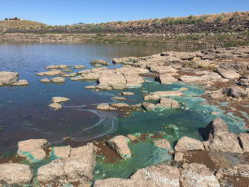Health advisory issued for Little Camas Reservoir

Elmore, ID — Central District Health (CDH) and the Idaho Department of Environmental Quality (DEQ) have issued a health advisory for Little Camas Reservoir located in Elmore County. Residents are urged to use caution when recreating in or near the water. Currently, 16 advisories are in place throughout Idaho. Health advisories issued by CDH and DEQ on July 31, 2019 for Mountain Home Reservoir (Elmore County) and Indian Creek and Blacks Creek Reservoirs (Ada County) remain in effect.
Recent samples taken from Little Camas Reservoir indicate high concentrations of toxin-producing cyanobacteria, which can be harmful to people, pets, and livestock. Those with liver or kidney damage are at an increased risk of illness.
Cyanobacteria are a natural part of Idaho’s water bodies. When temperatures rise, their populations can bloom and toxic chemical compounds, or cyanotoxins, can be released into the water. Blooms can vary in appearance, and may look like mats, foam, spilled paint, or surface scum, and have a foul odor. While
blooms can be discovered in one area of recreational water, they can move around to different areas, water depths and can change in severity.
When recreating near or in any surface water with a health advisory in effect, take the following precautions:
Avoid swimming, wading, or other activities. Take extra precautions to ensure children, pets, and livestock are not exposed to the water.
Do not drink or cook with water containing a bloom. Boiling and filtering the water can increase the risk.
Wash your hands thoroughly after handling fish caught in water experiencing a bloom.
Cyanotoxins can accumulate in fish and the risk to people is being researched. Any fish caught should be cleaned and washed thoroughly in uncontaminated water and any internal organs disposed of before consumption. If people choose to eat fish from this area, filet the fish and remove all of the fat, skin, and organs before cooking.
Clean with potable water as soon as possible if water contacts skin or pet fur.
Symptoms of cyanotoxin exposure include rashes, hives, diarrhea, vomiting, coughing, and/or wheezing. More severe symptoms affecting the liver and nervous system may result from ingesting water. If symptoms persist, consult your healthcare provider.
The public will be advised when it is likely the concern no longer exists.
More Information / How to Report a Potential Harmful Algal Bloom
For information on cyanobacteria blooms and a map of recreational water quality health advisories in Idaho, visit www.deq.idaho.gov/recreation-health-advisories. Many harmful algal blooms are identified through public reporting. If you suspect a bloom on a recreational water body in Idaho, report it to DEQ
